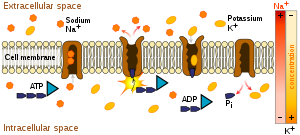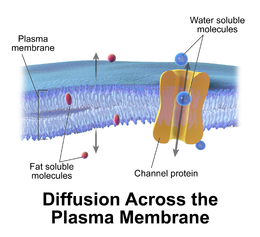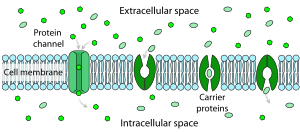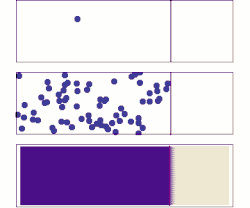Proteins are said to be the large molecules that are complex in nature and play much vital role in working of organs in body.
Carrier protein are the ones that tend to carry the substances form one of the side to the other in the bio membrane. Passive diffusion is the process by which molecules diffuse from a region of higher concentration to a region of lower concentration. These are mostly seen in the membrane of the with the carrier proteins types being-
- Active transport
- Passive transport
- Facilitated diffusion
- Valinomycin
- Glucose-Sodium contransport
- Sodium potassium pump
- ATP, light or elctropotential driven

Active transport
This is the very first carrier proteins types. On this context these need up energy to move the materials against its concentration ratio or gradient.
This energy might be seen to come from the ATP in its own triphosphate form that shall be sued by the protein in direct basis being a carrier or also might be used as the energy from any other source. Some many changes its shape to work. Active transport occurs when a solute must pass through the cell membrane.

There are also certain examples for it like that of the pumps for potassium and sodium that keeps its energy stored in form of ATP by changing its shape being a carrier proteins types. The carrier proteins types with this transport for mostly have a transport that is secondary in its active manner and are also sometimes called to be coupled carriers.
They use the manner for the secondary system of transport and are also sometimes called to have the urge of having the transport of the uphill type for another. The coupled carriers are lie the other carrier proteins types wit ending most of the gentrify of the cell as it keeps the concentration of the mineral gradient intact in the carrier and used the energy.
Passive diffusion
It is the main carrier proteins types and also the vital root for getting the xenobiotics and also have many trait governing it.
It is one of the carrier proteins types with being complete alternate to the active diffusion method and does not use any kind of pump with rather relying on the much natural way of diffusion that does not even use any of the pumps.

The natural method of its way contain the analytics along with having from the air form the sampling medium. There are also many samplings details given to this and are much in simple to use. It is said to be one among the carrier proteins types that is easy having the plasma membrane also with it to carry out its function with having the molecules transported.
At this carrier proteins types, the molecules tend to cross the plasma membrane via this way helping the molecules cross the other side. At this time, the molecule needed to be delivered easily dissolved in the bilayer of phospholipid and gets its diffusion across it and then again melts in the aqueous solution at the other part of the membrane.
Facilitated diffusion
The carrier proteins types also tend to carry many of the proteins that follow the way of downward or downhill method of reacting.
This means that this carrier proteins types intend to carry the molecules via the concentration gradient in the way of which the materials wants themselves to travel. One example for this can be the valinomycin carrier of proteins. Facilitated diffusion is the process of spontaneous passive transport of molecules or ions across a biological membrane.

Here the molecules do diffuse in the way of getting across the plasma membrane along with the help of the proteins in membranes like that of the channels or the carrier making it a good carrier proteins types. There is also a presence of concentration gradient seen for all of the carrier proteins types and also for all the molecule linked to this.
It is said to be the movement of molecules that are passive and also accords the membrane of cell via the help if the membrane proteins. It is used by the molecules that are not able to get its way freely across the layer of phospholipid just like the polar molecules and the ions and are much have molecules that are large connected to it.
Valinomycin
This is said to be the carrier proteins types with also called the passive transport carrier for its method of working.
This is actually a protein type that links itself with the potassium and also carriers itself across the cell membrane down the gradient of concentration in the way of which the potassium wants itself to move just like the way facilitated way works.

It is seen in the membrane of the cell of the strep bacteria that tend to sue it for wanting to move the mineral which is the potassium out if the cells. It is much high in its selectivity for the mineral intake and only gives efforts to advantage getting over the other that help is in accomplishing the transport with being much ready to move in with the rest.
It is much commonly said that this carrier proteins types sound much like an antibiotic with its also being such that helps on removing the bacteria like that of the strep and also has an advantage over many other carrier proteins types. It is so as it gets to introduce itself to the bacteria in an unnatural manner.
Glucose sodium contransport
It is a protein and is a good unit for carrier proteins types and also for the one that used the way of secondary way of transfer or indirect way.
They are a good carrier proteins types with being the one that tends to have cells that maintain the ATP and the potassium with sodium gradient between the outer and in of the cell. Mostly this cell tries to keep the concentration high without area and potassium being high inside.

This carrier proteins types tends to have a lot of power with the cell allowing the couple of the sodium ions in to get along with the glucose. The carrier proteins links to both of the glucose molecule that do not tend to shift or move itself in the cell and also gets the two of the sodium ions in its places with both binding the molecule of glucose.
The sodium ins in this carrier proteins types tend to have the energy or want to get in but its overrides the resistance of the glucose and also of the tree material are made to move in the cell altogether. This carrier proteins types gas secondary transport and is called the symport with implying the mobbing of three particles and having two materials in the same order to assure its way.
Sodium-Potassium pump
This carrier proteins types tend to use the transport of ATP for both the potassium and the sodium ions against all the transport gradient type.
Here in this carrier proteins types the proteins tends to use ATP to get the material transport itself form one place to other. Both the potassium and the sodium tend to get against the gradient of transportation with binding to each other.

The protein here bids with the ions of sodium that are seen in the cell with in the same time also linking with the potassium in the cells. After the binding, these carrier proteins types are complete on the number of ions it has on both of the sides with it binding to the molecule of ATP. By having to release the energy stored in the ATP it changes its shape to move with both parts of ions.
This carrier proteins types are vital for its use in the function if the animals nerve and is seen to have use of about 20 to 25% of all the ATP present in the human body. The potential can be made with extreme different in the level of concentration between the ions of both mineral in and also out of the cells with linking go also many type of ailments.
ATP, light or elctro-potential driven
A protein is involved in both these methods of transport, neither method requires energy. Protein channels and carrier proteins are involved in passive transport.
They are also the proteins that take up glucose molecules and transport them and other molecules. a carrier protein is a type of protein that transports a specific substance through intracellular compartments, into the extracellular fluid.
Carrier proteins that are involved in carrier-mediated diffusion are those that are driven by a concentration gradient and not by ATP hydrolysis. They transport molecules from an area of high concentration to an area of low concentration. It includes the carrier proteins types.
Carrier proteins that transport molecules against the concentration gradient are those that use substantial energy. ATP-driven carrier proteins are those requiring ATP to transport molecules whereas electrochemical potential-driven proteins are those fueled by electrochemical potential.
Types of carrier proteins in passive transport
Carrier proteins that transport molecules against the concentration gradient are those that use substantial energy with carrier proteins types.
Depending on the energy source, the carrier proteins may be classified as – ATP-driven, electrochemical potential-driven, or the light-driven. These are the carrier proteins types. All channel proteins and many carrier proteins allow solutes to cross the membrane only passively carrier proteins types.

While carrier proteins are capable of performing active transport, they can also perform passive transport. Valinomycin, for example, passively transports potassium down its concentration gradient. It is used instead of a channel because it is highly selective and transports potassium ions with the carrier protein types.
Therefore these are still types of passive transport. . This is a carrier proteins types with also having example like simple diffusion and also osmosis along with facilitated diffusion. Facilitated diffusion therefore allows polar and charged molecules, such as carbohydrates, amino acids, nucleosides, and ions, to cross the plasma membrane.
Function of carrier proteins
Carrier proteins bind specific solutes and transfer them across the lipid bilayer by undergoing conformational changes that expose the solute-binding site sequence.
Carrier proteins are responsible for the facilitated diffusion of sugars, amino acids, and nucleosides across the plasma membranes of most cells. The use of carrier proteins types or the function for carrier proteins are-
- Carrier proteins required for facilitated transport and active transport.
- Acts as the passage of molecules such as glucose and amino acids across the plasma membrane.
- Also acts a passage for minerals even though they are not lipid soluble.
- A carrier protein speeds the rate at which a molecule crosses a membrane
- Helps in getting the flow from a higher concentration to a lower concentration.
- A channel protein, a type of transport protein, acts like a pore in the membrane that lets water molecules or small ions through quickly
- Channel proteins, in contrast, interact with the solute to be transported much more weakly.
- Carrier proteins are responsible for the diffusion of sugars, amino acids, and nucleosides.

The carrier proteins involved in facilitated diffusion simply provide hydrophilic molecules with a way to move down an existing concentration gradient rather than acting as pumps. Channel and carrier proteins transport material at different rates. Carrier proteins also called carriers, permeases, or transporters bind the specific solute to be transported.
Channel proteins are proteins that have the ability to form hydrophilic pores in cells’ membranes, transporting molecules down the concentration gradient. Carrier proteins are integral proteins that can transport substances across the membrane, both down and against the concentration gradient. Carrier proteins bind to a molecule of the substance on one side of the membrane.
Conclusion
With regards to the context of this article, there are few carrier proteins types with all differing in its won way and also along with having different modes of transportation. The ones that finds its ways for carrier proteins types are the Active transport, passive transport and Facilitated diffusion being common.
Also Read:
- Diffusion in cell membrane
- Calvin cycle process
- Cytoplasm and protoplasm
- Brain anatomy
- Seed plant example
- Hydrophobic tail
- Protoctista examples
- Is cell plate a cell wall
- Nucleic acid
- Is fatty acid polar
I am Ankita Chattopadhyay from Kharagpur. I have completed my B. Tech in Biotechnology from Amity University Kolkata. I am a Subject Matter Expert in Biotechnology. I have been keen in writing articles and also interested in Literature with having my writing published in a Biotech website and a book respectively. Along with these, I am also a Hodophile, a Cinephile and a foodie.

Hi Fellow Reader,
We're a small team at Techiescience, working hard among the big players. If you like what you see, please share our content on social media. Your support makes a big difference. Thank you!